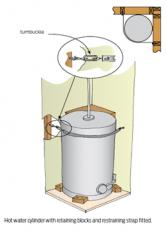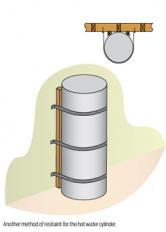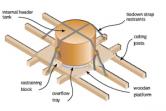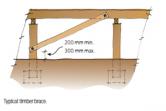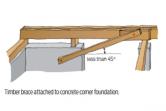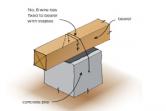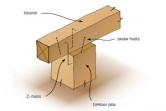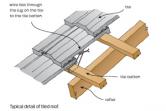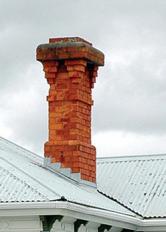How to reduce the risk of earthquake damage
To prepare your home to cope better in an earthquake you can:
- strap hot water cylinders and heat pump water heaters at the top and bottom to the wall framing using 25 × 1 mm galvanised steel straps that are tensioned when fixed in place. Tanks over 200 litres should have a third strap around the centre. Fix each strap to wall framing at both ends with 8 mm coach screws and a 30 × 2 mm thick washer or two 20 × 2.5 mm washers. The screws must penetrate the framing at least 50 mm. With retrofits, additional framing may be needed for adequate strap fixing.
- if you have a older style of water supply with a header tank, tie it securely to its base (roof space or on the roof); ensure the base is also securely fixed
- if there is no subfloor bracing already, provide lateral bracing support to piles. Fix timber braces at a slope no more than 45° – flatter slopes are better. Connect each brace to framing parallel with it, i.e. pile to bearer or pile to joist. Sheet bracing (treated plywood or fibre-cement) can also be used so long as it does not reduce subfloor ventilation. You can find technical guidance in two BRANZ bulletins, BU536 Upgrading piled foundations to resist earthquakes and BU674 Seismic retrofitting houses with piled foundations on sloping sites.
- ensure that piles are solid. Replace rotted timber piles. Connections such as wire ties or straps to bearers must be secure – a house not tied down can slide off its piles in an earthquake. Replace corroded fixings. Timber piles and bearers should be fixed together with hot-dip galvanised Z nails and skew nails. With concrete piles, a galvanised wire should go through the hole in the pile and be firmly stapled to the bearer with galvanised staples.
- simple retrofit solutions are also available to strengthen foundations of existing houses on sloping hillsides. You can find an outline of a BRANZ research project about this here
- ensure that concrete or clay roof tiles are tied or fixed to tile battens
- anchor solid fuel appliances by bolting to the hearth or through the floor
- secure a chimney to the structure and strengthen it. An assessment of structural strength by an engineer may be required. Alternatively, remove the chimney. Removal of an unsound chimney does not require a building consent for any building up to 3 storeys high as long as the removal does not affect the primary structure, any specified system or any fire separation (which includes firewalls protecting other property). Necessary repair work such as making good the gaps left in a roof after chimney removal can also be done without a consent.
Within the home:
- ensure that cupboard doors have a positive latch to hold them closed
- fix bookshelves and cabinets to the wall with 'L' shaped brackets
- provide a lip to the front edges of shelves so items are less likely to fall off
- store heavy items close to the floor.

